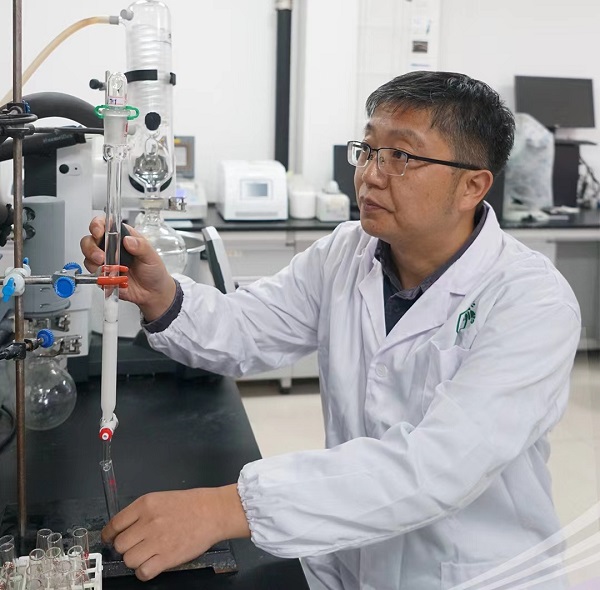|
青年创新奖名单
|
历届青年创新奖
 黄胜雄,生于1978年3月。博士,中国科学院昆明植物研究所研究员,博士生导师。2001年在陕西师范大学化学系获学士学位,2001-2004年在中国科学院成都生物研究所获天然产物化学硕士学位、2004-2007年在中国科学院昆明植物研究所获植物化学博士学位。2007年至2013年先后在香港赛马会中药研究院、美国威斯康辛大学药学院和美国Scripps研究所从事天然产物相关的博士后研究工作。2013年以国家高层次人才青年项目引进回昆明植物研究所独立开展研究工作。目前担任植物化学与西部植物资源持续利用国家重点实验室副主任,《Medicinal Plant Biology》等杂志的副主编和编委,中国植物生理与分子生物学会植物代谢专委会委员,中国生物化学与分子生物学会酶学专业委员会委员和云南省植物学会理事等职。主要利用多学科交叉研究手段的解析植物次生代谢产物的生物合成以及生物合成途径和基因的进化和演变历史。主要研究结果以通讯作者发表在PNAS、Nat Commun、JACS、Angew Chem和New Phytol等杂志上,部分研究成果作为研究热点被评述。2022年获得国家基金委杰出青年基金项目资助、2019年入选中共中央组织部国家“万人计划”科技创新领军人才、2015年获得国家基金委优秀青年基金项目资助、 黄胜雄博士近年来利用天然产物化学、分子与生物化学、结构生物学和基因组学等多学科交叉的研究手段,针对植物源托品烷生物碱莨菪碱和可卡因的骨架合成和途径的进化起源开展研究并取得了系列创新成果。 1. 植物药莨菪碱和可卡因的生物合成解析 植物药物分子莨菪碱和可卡因都是植物化学学科起源的天然产物之一,全球科学家围绕其生物合成的解析攻关了近30年,仍然未取得突破。黄胜雄博士解析了莨菪碱和可卡因基本骨架的生物合成化学机制及相关基因,回答了长久困扰学术界的百年生物合成难题,被40多个国际媒体和科普杂志报道,同时也被誉为改写天然药物化学教科书的工作。同时从多个角度阐释了一百年前Robinson的经典托品酮全合成与解析的生物合成途径如出一辙,说明经典托品酮化学合成是仿生合成。莨菪碱合成途径的系列工作发表后,斯坦福大学的教授利用已解析的莨菪碱生物合成基因在酵母中生产药物莨菪碱,说明该工作为创新性地应用合成生物学技术解决植物药资源问题提供了可能。 2. 远源植物类群中托品烷生物碱合成途径的进化 探究了可卡因和莨菪碱这两类化学结构相似的托品烷生物碱在远源植物金虎尾目和茄目中代谢途径的进化,测定并组装了三分三和古柯两种植物的高质量基因组。通过比较基因组学和生物合成功能蛋白的结构分析揭示了茄目中的可卡因的合成基因和金尾虎目中是趋同进化的产物。该研究揭示了茄目和金尾虎目植物中托品烷生物碱整条生物合成路径化学趋同而基因独立进化的特有现象,同时也提供了一个基于结构生物学、天然产物化学和基因组学研究植物次生代谢进化的新角度和案例。 Dr. Sheng-Xiong Huang, born in March 1978, is principal investigator and PhD supervisor at the Kunming Institute of Botany, Chinese Academy of Sciences (CAS). He obtained his bachelor's degree from the Chemistry Department of Shaanxi Normal University in 2001, a master's degree in Natural Product Chemistry from the Chengdu Institute of Biology, CAS in 2004, and his PhD in Phytochemistry from the Kunming Institute of Botany, CAS in 2007. From 2007 to 2013, he pursued postdoctoral research in natural products at the Hong Kong Jockey Club Institute of Chinese Medicine, the School of Pharmacy at the University of Wisconsin-Madison, and the Scripps Research Institute in the United States. In 2013, he returned to the Kunming Institute of Botany, CAS under the National High-Level Talents Youth Program to conduct independent research. Currently, he serves as the Deputy Director of the State Key Laboratory of Phytochemistry and Plant Resources in West China, Kunming Institute of Botany, CAS, Associate Editor and Editorial Board member for journals like "Medicinal Plant Biology", a committee member of the Plant Metabolism branch of the Chinese Society of Plant Physiology and Molecular Biology, and a committee member of the Enzymology branch of the Chinese Society of Biochemistry and Molecular Biology, as well as a board member of the Yunnan Botanical Society. He primarily utilizes interdisciplinary research methods to decode the biosynthesis of plant secondary metabolites, and the evolutionary history of genes and biosynthetic pathways. As the corresponding author, his research findings have been published in journals like PNAS, Nat Commun, JACS, Angew Chem, and New Phytol, with some of the research being reviewed as research hotspots. In 2022, he was awarded the National Science Fund for Distinguished Young Scholars from the National Natural Science Foundation of China. In 2019, he was selected as the Leading Talent of scientific and technological innovation of the national "Ten Thousand Talents Plan" by the Organization Department of the Central Committee of the Communist Party of China, and in 2015, he received the Excellent Young Scientists Fund from the National Natural Science Foundation of China. In recent years, by employing interdisciplinary research methods involving natural product chemistry, molecular and biochemistry, structural biology, and genomics, Dr. Sheng-Xiong Huang has achieved a series of innovative research breakthroughs related to the mechanisms, origin, and evolution of tropane alkaloid (hyoscyamine and cocaine) biosynthesis. 1. Decoding biosynthetic pathways of plant-derived medicines hyoscyamine and cocaine Plant-derived medicines hyoscyamine and cocaine have witnessed the beginning of the discipline of phytochemistry. As early as 1917, the first presumption of tropane alkaloid biosynthesis was proposed by Robinson based on his landmark chemical synthesis of tropinone. After a century of exploration, the biosynthetic machinery of tropane skeletons in hyoscyamine and cocaine remains elusive. From 2019 to 2022, Dr. Huang’s group deciphered the key biosynthetic enzymes responsible for building the basic framework of hyoscyamine and cocaine, along with their respective reaction mechanisms, resolving a century-old conundrum that has long perplexed the biosynthetic researchers. This work has been covered by over 40 international media and popular science magazines and is acclaimed for its potential to reshape textbooks on natural drug chemistry. At the same time, these research findings indicated a high similarity between Robinson’s classic tropinone total synthesis a hundred years ago and the biosynthetic pathway of tropane alkaloids in plants, suggesting that Robinson's classic tropinone chemical synthesis is a form of biomimetic synthesis. Following the publication of this series of works, Dr. Smolke from Stanford University successfully achieved heterologous production of hyoscyamine in yeast using the deciphered genes involved in hyoscyamine biosynthesis. This demonstrates that these biosynthetic research works offer the potential for innovatively applying synthetic biology technology to tackle challenges related to medicinal plant resources. 2. Evolution of tropane alkaloid biosynthesis in phylogenetically distant species Cocaine and hyoscyamine, both featuring similar tropane skeletons, are found in plants of the Malpighiales and Solanales orders, respectively. To understand the evolutionary origins and trajectories of tropane alkaloid biosynthesis, Dr. Huang’s group generated the chromosome-level genome assemblies of cocaine-producing Erythroxylum novogranatense (Erythroxylaceae: Malpighiales) and hyoscyamine-producing Anisodus acutangulus (Solanaceae: Solanales). Comparative genomic and protein structure analysis provided strong evidence for the independent origins of serial tropane alkaloid biosynthetic enzymes in Malpighiales and Solanales lineages. This study explained the foundation for the chemotypic convergence of tropane alkaloids in phylogenetically distant species. Additionally, it could serve as an example for investigating the evolution of plant secondary metabolism through the application of structural biology, natural product chemistry, and genomics. |
版权所有 Copyright © 2015-2019 云南吴征镒科学基金会,All Rights Reserved 【滇ICP备05000394号】
地址:中国云南省昆明市蓝黑路132号 邮政编码:650201
点击这里联系我们
